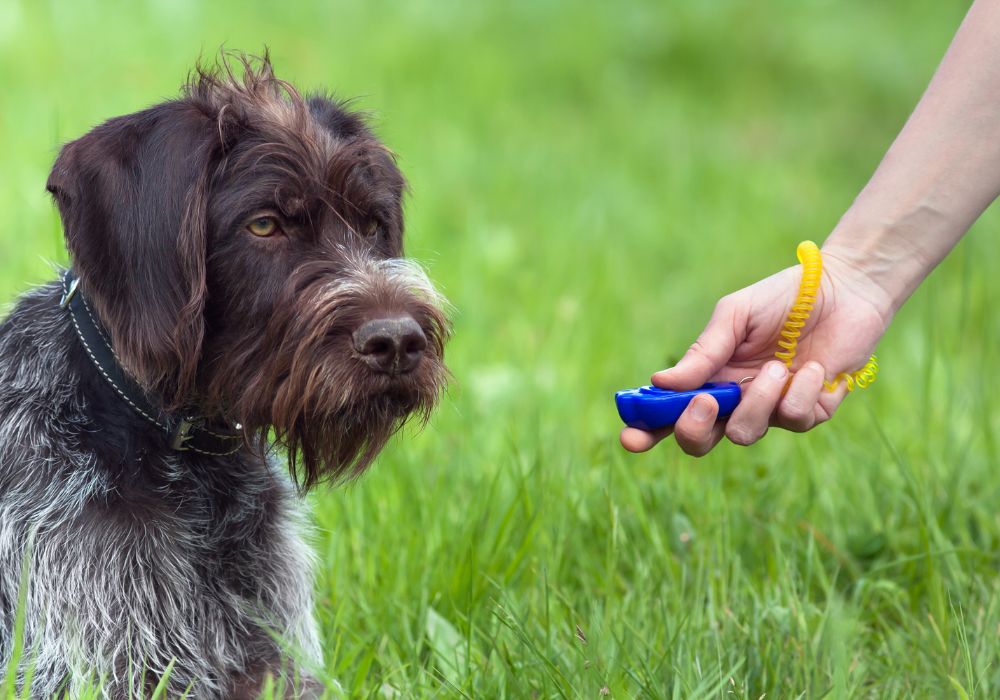Clicker Training for Dogs in 3 Easy Steps – Beginner’s Guide

Thankfully, you don’t need very advanced equipment to train your dog. Sometimes, simple works just as well.
Clicker training is a dog training method that is excellent for teaching young puppies. Using a clicker is pretty straightforward. Dogs and humans both automatically repeat behaviors that are rewarding for them and refrain from those that offer no benefit. Puppies pick up on appropriate behavior extremely fast. Pet owners don't need to be expert dog trainers to use this method.
What is a Clicker?
A dog training clicker is a metal strip enclosed in a little plastic box that, when pressed, emits a recognizable clicking sound. Dogs are taught during training that hearing a click signals a positive affirmation, instructing them on how to carry out the positive actions associated with hearing a click.

What You’ll Need for Clicker Training:
- Dog Training Clicker
- High-Quality Treats
- A Lot of Patience
Introducing the Clicker
When using a clicker to train your puppy, the goal is to get your pet to associate the “click” with a “reward.” In this case, we’re using high-quality treats. However, if your dog is not food-driven, you may substitute food with a different reward.
Before starting, test the clicker to ensure it isn't too noisy for your dog. When first exposed to a clicker, some pups become quickly worried. Another method is to silence it with your hand to make it a little less loud.
To start puppy clicker training, place the treat close to your dog's mouth while holding it in your hand and clicking. This will help the dog learn to associate sound with food. In the beginning, you only need to click and give a treat. Do this gradually over a few days.
Testing Your Dog
Is your dog ready to move to the next step? Test by clicking while your dog is not looking at you. If they respond by quickly looking at you and then searching for a treat, it’s time for the next step in training.
Clicking for Commands
Use the clicker to teach your pup some simple commands like "sit," “play dead,” or “roll-over.”

A few things to remember:
- Do not click directly on your dog’s face. They won’t like it.
- Use high-quality treats like pieces of meat orBy doing so, your pet learns that if they hear the click and obey the command, they will get delicious treats instead of the usual kibble.
- Your puppy won't understand what behavior earned the treat if you don't click at the appropriate moment. Accuracy and timing are one of the clicker's amazing advantages. The click and subsequent reward are connected in the pup's mind when they act. This helps them understand what they are doing better and increases the likelihood that your dog will repeat the activity if requested in the future.
Quick and Easy Clicker Training Step-by-Step Guide
- Sit comfortably on the floor and place the treats nearby but out of the dog's reach. Prepare a treat in one hand, then hold the clicker in the other.
- Ask your dog a basic command like “sit.” Press the clicker as soon as they sit on the floor. Don’t forget to give them a treat right after and praise them with words such as “Yes! Good Dog.”
- Repeat about 5-7 times until your puppy is familiar with the command.

Your dog will sometimes seem confused. They will approach you, possibly paw your leg, searching for the source of the "click" sound. Once more, sit, click and give a treat. Then observe the gears moving. Many puppies learn they can influence whether they receive a treat by their actions after just a few repetitions.
Clicker Training Mistakes to Avoid - Issues and Proofing
-
Forgetting to Give Praise
Although your dog has been taught to respond to the clicker, they also know how to behave to earn praise. Don't disregard a dog's desire for affirmation, attention, and love from their owner. Treats are great, but never forget to give praise for a job well done.
-
Not Timing the Click Correctly
You need solid hand and eye coordination to click at the exact time when using clicker training for more advanced actions or commands. Inability to do so will confuse your dog and result in ineffective training.
Frequently Asked Questions in Clicker Training:
-
Will you always need a clicker?
No. Although the clicker is a valuable tool for quickly teaching new tricks, the clicker is just a tool to build initial communication with your puppy. So, at some point, the clicker must say "bye-bye" to those addicted to using it and use it constantly for the same exercises.
-
Can I make the sound myself?
"Can't I just use my voice?" is one of the questions clicker trainers hear the most. The answer is, "Yes, you may!" The drawback is that you'll produce that sound while training roughly 50 times, which will wear you out. Instead, you may opt to use a marker word when clicker training. The most popular one is "Yes!". You must click on the clicker and incorporate the marker word "Yes!" after your dog has obeyed the command exactly how you wanted to. Afterward, you can phase out the clicker from clicking during training.
Clicker training is effective whether your dog is 8 weeks or 10 years old. Go try it out today!
-
Posted in
Dog Training, Pet Training, Training Tips